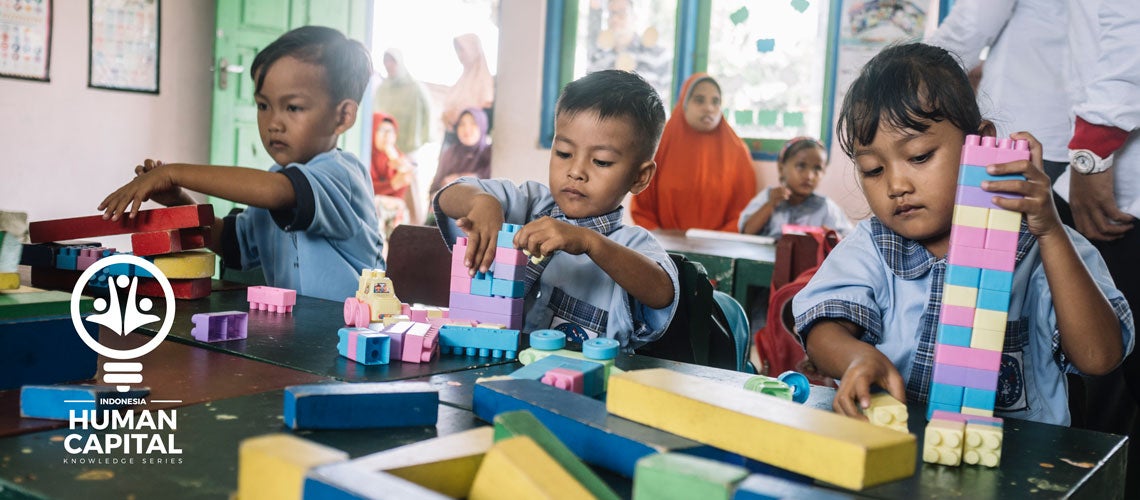 Pendidikan anak usia dini
Pendidikan anak usia dini
On July 15, 2019, during his first speech since being re-elected as President of the Republic of Indonesia, President Joko Widodo stated his priority for the nation in no uncertain terms - “We want to put our priority on human capital development. Human capital development will be key to Indonesia’s future.”
In Indonesia, the current state of human capital - the knowledge, skills, and health that people accumulate throughout their lives - does indeed demand significant attention. Indonesia’s score on the 2018 Human Capital Index is 0.53. This means that on average, an Indonesian worker of the next generation will only be 53% as productive as she or he could be under the benchmark of complete education and full health. While an Indonesian child today can expect to complete 12.3 years of school by their 18th birthday, due to low quality of education, he or she will on average receive only 7.9 years’ worth of learning. Additionally, nearly a third of Indonesian children remain stunted, meaning they are at risk of cognitive and physical limitations that can last a lifetime.
The commitment of the Indonesian government and the leadership of President Widodo to accelerate human capital development are already making a big difference. Over the past several years, the government has allocated significant resources and implemented several programs to improve education, health, and social protection. And while Indonesia continues to learn from other successful experiences - stunting reduction in Peru, improving learning outcomes in Vietnam, and successful social protection programs in Mexico and the Philippines, to name a few - it does not always have to look far to find a successful example of an impactful human capital program. Indonesia’s commitment to address its serious stunting problem has been strong and widespread and now other countries are starting to come here to see and learn. Just a few weeks ago, the Government hosted colleagues from India, Bhutan and Sri Lanka to learn about its stunting reduction efforts and how to implement and oversee all the convergence, coordination and management reforms needed to fix the complex problem of stunting.
Everyone must work together as you’d see in this short video.
The stunting program highlights the importance of leadership and commitment from all levels of government, and how coordination of programs and resources from different government agencies help families and children receive all the services that they need to maximize their human capital.
I have been fortunate to witness how this program makes a difference for the people who matter the most – the children who are born and growing up today. A few weeks ago, I met Ibu Ifa, a human development worker in Tangkilsari village in East Java. Her job is to work with local villages to close the gap in services that can lead to stunting. In just one year, Tangkilsari village has more than doubled the amount of Dana Desa (Village Funds) allocated specifically for stunting reduction activities - from IDR 35,000,000 in 2018 to IDR 78,200,000 in 2019. The funds are being used for supplementary feeding activities for pregnant mothers and babies, nutrition classes, and expenses for human development workers such as Ibu Ifa and ECED teachers. And Tangkilsari village is already seeing significant improvements in its stunting rate: in 2018, 39 children under age 5 were stunted, while in 2019, this figure fell to 25 children.
Last year, I met Ibu Nur, the Human Development Worker in Dakung village in Lombok. She also showed us her impressive work to help families ensure that their children do not grow up stunted. In only six months, she was able to work with the village head to ensure that 50 water connections were built and that a total of IDR 253,000,000 of Dana Desa was allocated to support the families at risk of stunting. Ibu Ifa and Ibu Nur both play important roles in the government’s National Strategy to Accelerate Stunting Prevention. Launched in 2017 and bringing together 23 ministries under the leadership of the President and Vice President, the Strategy serves as a model to close the human capital gap in Indonesia.
The following video explains the level of commitment that the government has given to address stunting.
President Jokowi was right when he said that human capital development will be key to Indonesia’s future. And while the stunting program shows what is possible, it is now time to also tackle, with the same level of commitment, coordination and partnership, Indonesia’s stubborn learning crisis and uneven health outcomes. Improving the basic and vocational education systems so that Indonesia’s youth graduate with the right set of skills for Industry 4.0 and have a better chance to compete for good jobs, will be key to Indonesia’s future growth and development. To achieve this, the focus needs to be on improving student learning. A National Education Quality Initiative could link to a strengthened assessment system of student learning, and include education spending data at all government levels to promote transparency, effectiveness and efficiency in the sector. On the health side, increasing tobacco taxes will have immediate health benefits, and the revenues can be used to strengthen preventative healthcare and implement a strong social protection system.
There is abundant global evidence showing that investments to close the human capital gap are productive and lead to significant returns. In Nigeria, workers’ earnings increased by 10 percent within the span of a few weeks after participating in a malaria testing and treatment program. In Kenya, a deworming program led to reduced school absences for children and ultimately, 20 percent higher wages as working adults. And here in Indonesia, a study found that Indonesian children who were stunted in 1993 demonstrated lower cognitive function as young adults in 2014-15, spent fewer years enrolled in formal education, and had lower adult earnings. Estimates also show that if Indonesia closes the gap between its current HCI score and the ideal scenario of full health and education at a rate of 4% per five years, the median rate among countries in the database, estimated GDP per capita would be 7.1% higher by 2050.[1]
Closing the human capital gap will mean that more Indonesian children will be born healthy, ready to learn once they start school, maximize what they learn, get better jobs, and remain healthy throughout their lives. Altogether, these achievements will give all Indonesians a chance to improve the quality of life for themselves, their families, their communities, and for those in the future generations to come.
This blog and the videos form part of the Indonesia Human Capital Knowledge Series. Please click here for more information.
[1] These results are derived from an economic situation model outlined in the following paper: Collin, Matthew Edward; Weil, David Nathan. 2018. The Effect of Increasing Human Capital Investment on Economic Growth and Poverty : A Simulation Exercise (English). Policy Research working paper; no. WPS 8590. Washington, D.C. : World Bank Group.


Join the Conversation